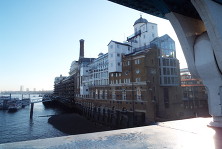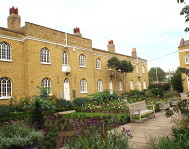








The Rose Theatre
Bankside carries the heritage of the Golden Age of Playhouses proudly but sadly the era was short-lived, cut short by austere politics and by fashion. For a few brief years the area was home to four playhouses –The Rose, The Swan, The Globe and The Hope but very little of any remains today. There is a plaque in Park Street that commemorates the Rose Theatre and by going through an unprepossessing set of doors it’s possible to enter and see the theatre’s foundations.
The Rose Theatre was the first of the Bankside theatres to be built and was modelled on The Theatre, the first purpose-built theatre in London constructed by James Burbage in Curtain Road, Shoreditch. Before then, public performances of plays took place in market squares or the courtyards of inns. Inns were easily adapted for the staging of plays as they had large courtyards where a stage could be erected temporarily. The courtyard was overlooked by galleried buildings which could be used alternatively as a musicians gallery, as a viewing area for the audience, in particular patrons and notables, and to accommodate parts of the action of the play, for example the balcony scene in Romeo and Juliet. James Burbage was a joiner and based his design of The Theatre on an inn’s courtyard and surrounding galleried buildings. It became the model for all Elizabethan playhouses.
The City of London banned the performance of plays within their jurisdiction in 1596 but the Rose was completed a few years prior to this. It was multi-sided, based on a 14 sided polygon, with a thatched roof and an open galleried courtyard with a stage projecting into it. It was built by Phillip Henslowe, a dyer by trade and a member of the Dyer’s Company. Born in Sussex he lived in the Clink Liberty and in 1587 went into partnership with John Cholmley who had a house in Rose Alley, named after a rose garden, which became the site of the Rose Theatre. Henslowe also worked in partnership with his step-son-in-law, Edward Alleyn, who was reputed to be one of the best actors of his generation. Henslowe’s company was known as The Admiral’s Men and they staged plays, by among others, Marlow, Dekker and Drayton. Henslowe opened the Fortune Theatre to the north of the city in 1600 where he transferred the bulk of his theatrical interests, perhaps because of the competition from the newly opened Globe Theatre on Bankside. Other theatrical companies used the Rose but it had been abandoned as a theatre by 1606.
The Rose Theatre, 56 Park Street, SE1
The foundations of the Rose Theatre were discovered in 1989 during routine archaeological works after clearing the site of a 1950s block in preparation for a new development. The developers wished to go ahead with the new build but a high profile campaign was launched to save the foundations. In the end a compromise was reached and the new build was suspended over the foundations of the Rose allowing for further archaeology and viewing by the general public. More information can be found about its history and events programme by visiting their website.
Web discoveries
- UK Casino Not On Gamstop
- UK Casino Not On Gamstop
- Non Gamstop Casino
- Casinos Not On Gamstop
- Non Gamstop Casinos
- Non Gamstop Casinos
- Non Gamstop Casino
- Casino Sites Not On Gamstop
- Slots Not On Gamstop
- Casinos Not On Gamstop
- UK Betting Sites Not On Gamstop
- UK Casino Not On Gamstop
- Best Non Gamstop Casinos
- Betting Sites
- Non Gamstop Casino Sites UK
- Best Non Gamstop Casinos
- Non Gamstop Casino
- Casinos Not On Gamstop
- Non Gamstop Casino Sites UK